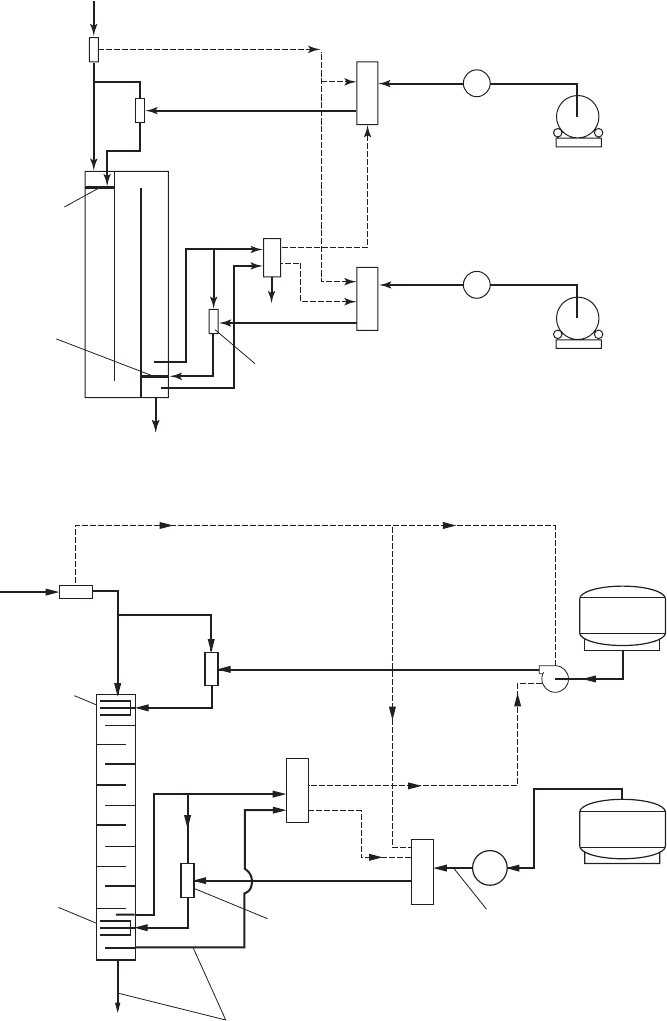Water and Wastewater Engineering
Подождите немного. Документ загружается.

25-16 WATER AND WASTEWATER ENGINEERING
used in dechlorination are sulfur dioxide gas (SO
2
) and sulfite compounds, such as sodium sulfite
(Na
2
SO
3
), bisulfite (NaHSO
3
), and metabisulfite (Na
2
S
2
O
3
).
Reaction Chemistry. The redox reactions are summarized as follows:
For sulfur dioxide and chlorine
SO H O HSO
22 3
H
(25-7)
HOCl HSO Cl SO H
3 4
2
2
(25-8)
or
SO HOCl H O Cl SO H
4
2
22
3
(25-9)
For sulfur dioxide and monochloramine
SO NH Cl H O Cl SO NH H
4
2
422 2
22
(25-10)
For sodium sulfite and chlorine
Na SO Cl H O Na SO HCl
2 3 22 24
2
(25-11)
For sodium sulfite and monochloramine
Na SO NH Cl H O Na SO Cl NH
42 3 22 24
(25-12)
For sodium bisulfite and chlorine
NaHSO Cl H O NaHSO HCl
3 22 4
2
(25-13)
For sodium bisulfite and monochloramine
NaHSO NH Cl H O NaHSO Cl NH
43 22 4
(25-14)
For sodium metabisulfite and chlorine
Na S O Cl H O NaHSO HCl
22 5 22 4
3 24
(25-15)
For sodium metabisulfite and monchloramine
Na S O NH Cl H O Na SO H SO Cl NH
422 5 2 2 24 24
2 3 22
(25-16)
While sodium thiosulfate and activated carbon will also dechlorinate, their application is imprac-
tical because of the low pH required for thiosulfate and the cost for activated carbon.
Reaction Kinetics. Dechlorination reactions are nearly instantaneous.
Chlorination and Dechlorination Practice
Dosage. Typical chlorine dosages are given in Table 25-7 .
Dechlorination dosages are based on the mg/L chlorine residual. Typical dechlorination dosages
are given in Table 25-8 .

SECONDARY SETTLING, DISINFECTION, AND POSTAERATION 25-17
Contact. Typical contact is in a baffled chamber or a pipe. Design of contact chambers is dis-
cussed in Chapter 13. The desired contact time is 30 minutes.
Chlorination and Dechlorination Design
Flow Diagrams. Typical chlorine/sulfur dioxide process flow diagrams are shown in Figure 25-7 .
Design Criteria. Design criteria for handling Cl
2
, NaOCl, mixing systems, and contact basins
are given in Chapter 13.
Ultraviolet Disinfection
UV disinfection is becoming increasingly popular as a means of disinfection. The elimination of
chemical disinfection reduces the hazard potential of the plant, operation and maintenance effort,
and the paperwork for numerous tracking requirements for the hazardous chemicals.
The principles of u ltraviolet irradiation and s
ources of UV radiation for disinfection are
discussed in Chapter 13. The following discussion highlights some of the issues in applying UV
to wastewater disinfection.
TABLE 25-8
Typical wastewater dechlorination dosages
Source: Metcalf & Eddy, 2003.
Note: based on combined chlorine and 30-minute contact time.
Source: Metcalf & Eddy, 2003.
TABLE 25-7
Typical chlorine dosages for wastewater
Chlorine dose, mg/L
Effluent standard, MPN/100 mL
Type of
wastewater
Initial coliform count,
MPN/100 mL 1,000 200
Trickling filter effluent 10
5
–10
6
3–10 5–20
Activated sludge effluent 10
5
–10
6
2–10 5–15
Filtered activated sludge effluent 10
4
–10
6
4–8 5–15
Nitrified effluent 10
4
–10
6
4–12 6–16
Microfiltration effluent 10
1
–10
3
1–3 2–4
Compound Range, mg per mg/L of chlorine residual
Sulfur dioxide 1.0–1.2
Sodium sulfite 1.8–2.0
Sodium bisulfite 1.5–1.7
Sodium metabisulfite 1.4–1.6

25-18 WATER AND WASTEWATER ENGINEERING
(b)
(a)
Control signal
Wastewater
effluent
Flowmeter
Injector
Injector
Chlorine gas
Chlorinator
Evaporator
Evaporator
Chlorine
gas
Compressed chlorine
gas storage
Liquefied sulfur
dioxide storage
Chlorine
diffuser
Chlorine
residual
analyzer
Chlorine
contact
basin
Sulfur
dioxide
diffuser
Dechlorinated
effluent
De
chlorinated
effluent
Drain
Sulfur dioxide gas
Sulfur
dioxide
gas
Sulfonator
Control
signal
Liquid
sodium
hypochlorite
storage
Feed
pump
Liquefied sulfur
dioxide storage
Liquid
sulfur dioxide
Evaporator
Sulfur dioxide gas
Sulfonator
Liquid sodium
hypochlorite
Control
signal
Injector
Control signal
Effluent
water
Chlorine
residual
analyzer
Sulfur dioxide gas
Injector
Sulfur dioxide
solution
Disinfected
effluent
Receiving
water
Chlorine
contact
channel
Sulfur dioxide
mixers/diffusers
Chlorine
diffusers/mixers
Flowmeter
Wastewater
effluent
Effluent water
Chlorine
solution
FIGURE 25-7
S chematic flow diagrams for chlorination/
dechlorination. Schematic ( a ) uses a chlo-
rine injector. Schematic ( b ) is for sodium
hypochlorite injection. Both schematic use
SO
2
for dechlorination.
( Source: Metcalf & Eddy, 2003.)

SECONDARY SETTLING, DISINFECTION, AND POSTAERATION 25-19
Effect of Wastewater Constituents. A number of wastewater constituents ad versely affect
the efficiency of UV disinfection. A selected list is presented in Table 25-9 . The raw water
constituents, for example, hardness, iron, manganese, and TDS, may reduce the efficiency
because they are either strongly adsorb UV, or they
coat the lamps. In some case they do both.
Of the typical wastewater constituents, oil, grease, and total suspended solids are of obvious
concern in the application of UV. Upstream processes that reduce the concentrations of these
constituents are a normal part of secondary treatment. This, c
ombined with special continuous
cleaning of the lamps, improves the prospects for using UV. The use of ferric chloride to
control phosphorus concentrations inhibits the implementation, but does not preclude the use
of UV.
UV Design Practice. In sm all plants, the UV system is enclos ed. In medium-to-large plant
s,
UV systems are placed in an open channel. Typically, two parallel channels are provided. A
water level controller is placed at the effluent end to keep the lamps submerged. In the majority
TABLE 25-9
Impact of wastewater constituents on the use of UV radiation for wastewater disinfection
Constituent
a
Effect
BOD, COD, TOC, etc. No or minor effect, unless humic materials comprise a large
portion of the BOD
Humic materials Strong adsorbers of UV radiation
Oil and grease Can accumulate on quartz sleeves of UV lamps, can absorb UV
radiation
TSS Absorption of UV radiation, can shield embedded bacteria
Alkalinity Can impact s
caling potential. Also affects solubility of metals
that may absorb UV light
Hardness Calcium, magnesium, and other salts can form mineral deposits
on quartz tubes, especially at elevated temperatures
Ammonia No or minor effect
Nitrite No or minor effect
Nitrate No or minor effect
Iron Strong adsorber of UV ra
diation, can precipitate on quartz
tubes, can adsorb on suspended solids and shield bacteria
by adsorption
Manganese Strong adsorber of UV radiation
pH Can affect solubility of metals and carbonates
TDS Can impact scaling potential and the formation of mineral
deposits
Industrial discharges Depending on the
constituents (e.g., dyes), may lead to diurnal
and seasonal variations in the transmittance
Stormwater inflow Depending on the constituents, may lead to short-term as well as
seasonal variations in the transmittance
a
Inorganic constituents including bicarbonate, chloride ion, and nitrate can affect the direct UV photolysis of
constituents such as N-nitrosodimethylamine (NDMA).
( Source: Metcalf & Eddy, 2003.)

25-20 WATER AND WASTEWATER ENGINEERING
of UV disinfection applications, low-pressure mercury lam ps have been used (WEF, 1998).
Medium-pressure, high-intensity lamps have found application in larger plants where the flow
rate exceeds 20,000 m
3
/ d (Hanzon and Vigilia, 1999). The advantage of the medium-pressure,
high-intensity lamp is that the UV output can be modulated over a range of 60 to 100 percent of
full power. In addition, fewer lamps are required.
Q uartz sleeves are used to isolate the lamps from d irect water contact and to control the
wall temperature. Mechanical wiping or a periodic acid
dip of the sleeve is essential to avoid the
formation of an opaque film. Mechanical wiping is preferred because of the lower labor require-
ment for maintenance.
The dose to achieve regulatory standards is typically in the range of 50 to 140 mJ/cm
2
.
Using higher doses to overcome elevated suspended particulate matter concentrations has proven
ineffective (Metcalf & Eddy, 2003). Filtration prior to disinfection and conservative estimates of
dose are recommended.
Factors that affect the number, type, and rating of lamps include (1) the h
ydraulic loading
rate, (2) the aging and fouling characteristics of the lamps, (3) the wastewater quality, and (4) the
discharge standards. Typical design parameters are summarized in Table 25-10 . Because the UV
system is preassembled, the design engineer’s role is limited to asse
ssment of existing configura-
tions. For existing facilities, pilot testing is highly recommended.
Hints from the Field. Those with field experience have made the following suggestions:
• Step one for UV retrofit or upgrade is a long-term study (preferably one year) of UV trans-
mittance at 254 nm wavelength. Transmittance values frequently ma
y fall below the typical
design value of 65 percent. Periodic excursions below 50 percent have been observed at
some plants (Youngberg and Marko, 2008).
• Early sleeve wiping systems had maintenance issues. Careful evaluation should be made .
Design parameter Range of values
Contact time 6–40 s
Lamp life
Low pressure 8,000–12,000 h
Medium pressure 4,000–6,000 h
UV dosage
Secondary treatment 50–140 mJ/cm
2
After granular filtration 100 mJ/cm
2
After membrane filtration 80 mJ/cm
2
After reverse osmosis50 mJ/cm
2
Wastewater velocity 0.05–0.4 m/s
Sources: Hanzon and Vigilia, 1999; Metcalf & Eddy, 2003; WEF,
1998.
TABLE 25-10
Typical UV system design parameters

SECONDARY SETTLING, DISINFECTION, AND POSTAERATION 25-21
25 -4 POSTAERATION
Requirements for increased dissolved oxygen (DO) levels have become standard for discharge
to water-quality limited stream sections and to effluent dominated waters. If sufficient elevation
head is not available, surface or diffuse aerators are employed. Cascade aeration is
the simplest
alternative available if sufficient elevation is available.
The most common method for determining the required cascade height for wastewater is that
given by Barrett (1960):
H
R
b
deficit
T
1
0 289 1 0 046..()( )
(25-17)
where H height through which wastewater must fall, m
R
deficit
deficit ratio
CC
CC
so
s
(25-18)
C
s
DO saturation concentration of the wastewater at temperature T, mg/L
C
o
DO concentration of the influent to the cascade, mg/L
C DO required, mg/L
b weir geometry parameter: for a broad-crested weir, b 1.0; for steps, b 1.1; for
step weir, b
1.3
T wastewater temperature, C
T ypical design criteria are given in Table 25-11 . Example 25-4 illustrates the calcu lation of the
cascade height. An alternative to Barrett’s approac h is through the use of v-notch weirs or cas-
cade structures in clarifiers (Bagatur, 2009). When there is insufficient elevation for a cas
cade to
be employed, a conventional bubbler aeration system may be used.
Source: Metcalf & Eddy, 2003.
Parameter Range Typical
Hydraulic loading rate at average
design flow, m
3
/m of width · d 1,240–6,200 3,000
Step dimensions
Height, mm 150–300 200
Length, mm 300–600 450
Cascade height, m 2–5
TABLE 25-11
Typical cascade design ranges

25-22 WATER AND WASTEWATER ENGINEERING
Example 25-4. The dissolved oxygen in the effluent from an oxidation pond must be increased
from 1.0 mg/L to 4.0 mg/L before discharge. The average summer water temperature in the
oxidation pond is 25 C. Estimate the height of a step cascade to achieve 4.0 mg/L DO.
Solution:
a . From Appendix A, find the DO saturation concentration at 25
C is 8.38 mg/L
.
b. Calculate the deficit ratio.
R
deficit
mg/L mg/L
mg/L mg
8 3810
8 3840
..
..
//L
168.
c. Calculate the height of the cascade.
H
168 1
0 289 1 1 1 0 046 25
068
0683
.
.. .
.
.()()[ ()]
55
1 m
Comment. The summer water temperature is selected because this gives the critical R
deficit
for
design.
25-5 CHAPTER REVIEW
When you have completed studying this chapter, you should be able to do the following without
the aid of your text or notes:
1 . Describe the difference between the settling of trickling filter and activated sludge.
2. Sketch a solids flux curve you have drawn and identify the following: gravity flux
curve, overflow rate operating line, underflow operating line, and the maximum solids
flux rate.
3. Given a state point analys
is, evaluate the performance of the secondary clarifier and
make recommendations for possible operating changes.
4. Explain why the discharge limit for fecal coliform concentration may change with the
seasons.
5. Explain why wastewater must be dechlorinated after disinfection with chlorine com
-
pounds.
6. Explain the advantages and disadvantages of UV disinfection.
Visit the text website at www.mhprofessional.com/wwe for supplementary materials
and a gallery of photos.

SECONDARY SETTLING, DISINFECTION, AND POSTAERATION 25-23
W ith the aid of this text, you should be able to do the following:
7 . Design a secondary settling tank for a trickling filter plant.
8 . Design a secondary settling tank for an activated sludge plant.
9. Design a chlorine disinfection system for a wastewater plant.
10. Design a postaeration cascade.
25 -6 PROBLEMS
25 -1. The two settling tanks at Turkey Run (Problem 23-21 in Chapter 23) are 16.0 m in
diameter and 4.0 m deep. The effluent weir is a single launder set on the tank wall.
Evaluate the overflow rate, depth, solids loading, and weir length for conformance to
standard practice.
25 -2. The single secondary settling tank at Lotta Hart Hospital (Problem 23-23 in Chapter 23)
is 10.0 m
in diameter and 3.4 m deep at the side wall. The effluent weir is a single launder
set on the tank wall. Evaluate the overflow rate, depth, solids loading, and weir length for
conformance to standard practice.
25-3. Your firm has been asked to design a new secondary clarifier for a conventional
activated sludge plant. The MLSS concentration i
s 3,000 mg/L, the flow rate is
8,000 m
3
/ d, and the recycle ratio is 0.46. The desired RAS concentration is 10,000
mg/L. Use the following column settling data (Peavy et al., 1985):
MLSS, mg/L Settling velocity, m/h
1,400 3.0
2,200 1.85
3,000 1.21
3,700 0.76
4,500 0.45
5,200 0.28
6,500 0.13
8,200 0.089
To complete the design, provide the following:
(1) limiting solids flux rate
(2) solids loading rate
(3) overflow rate
(4) diameter
(5) depth

25-24 WATER AND WASTEWATER ENGINEERING
25 -4. Your firm has been asked to design a new secondary clarifier for an extended
aeration activated sludge plant. The MLSS concentration is 2,000 mg/L, the flow
rate is 4,200 m
3
/ d, and the recycle ratio is 0.46. The desired RAS concentration is
10,000 mg/L. Use the following column settling data (Peavy et al., 1985):
MLSS, mg/L Settling velocity, m/h
1,000 2.8
2,000 1.4
3,000 0.4
4,000 0.2
5,000 0.1
6,000 0.06
To complete the design, provide the following:
(1) limiting solids flux rate
(2) solids loading rate
(3) overflow rate
(4) diameter
(5) depth
25 -5. A wastewater is to be dechlorinated using sulfur dioxide. Estimate the stoichiometric
dose to ne
utralize a chlorine residual of 6.5 mg/L.
25 -6. A wastewater is to be dechlorinated using sodium metabisulfite. Estimate the stoi-
chiometric dose to neutralize a chlorine residual of 6.5 mg/L.
25 -7. Using typical design parameters, design a postaeration casc ade for the town of
Bath (Problem 2
3-38, Chapter 23). To m eet regulatory requirements, the DO must
be 5.0 mg/L. Assume that the SBR plant is using post-SBR equalization, that
the effluent DO is 2.0 mg/L, and that the m aximum sustained temperature is 21 C.
25 -8. Design a postaeration cascade for the city of Pittsburgh (Problem 23-46, Chapter 23).
The maxim
um day flow rate is estimated to be 1.80 times the average design flow rate.
To meet the regulatory requirements, the DO must be 4.0 mg/L. Assume that the plant
effluent DO is 0.0 mg/L and that the maximum sustained temperature is 24 C. Although
ample elevation is available for a cascade, the linear space along the river bank is limited.
25 -7 DISCUSSION QUESTIONS
25 -1. Explain when a design engineer would select a rectangular rather than a circular sec-
ondary clarifier and what, if any, negative impacts this may have on performance.
25 -2. Sketch a curve of a solids flux analysis and draw a line that defines the limiting flux.
Identify the limiting flux on the graph.
25 -3. Given that deeper
secondary settling tanks perform better, what limits the depth?
SECONDARY SETTLING, DISINFECTION, AND POSTAERATION 25-25
25 -4. Explain why UV disinfection has become a popular alternative to chlorine disinfection.
25 -5. What is the major impediment to the use of a cascade for postaeration?
25 -8 REFERENCES
Albertson, O. E. (2008) “Solids Loading Limitations of Rectangular Secondary Clarifiers,” Journal of
Environmental Engineering Division, A merican Society of Civil Engineers, vol. 134, no. 1, pp. 14–21.
Albertson, O. E. and J. P. Wilson (1997) “Clarifier Design Concept—Larger Is Better,” Journal of
Environmental Engineering, November, pp. 1,159–1,162.
Bagatur, T. (2009) “Evaluation of Preaeration with V-notch and Cascade Structures in Clarifiers,” Journal
of Environmental Engineering, vol. 135, no. 3, pp. 176–184.
Barrett, M. J. (1960) “Aeration Studies of Four Weir Systems,” Water and Wastes Engineering, vol. 64,
no. 9, pp. 407.
Davis, M. L. and D. A. Cornwell (2008) Introduction to Environmental Engineering, McGraw-Hill,
Boston, Massachusetts, pp. 510–513.
GLUMRB (2004) Recommended Standards for Wastewater Facilities, Great Lakes–Upper Mississippi
River Board of State and Provincial Public Health and Environmental Managers
, Health Education
Services, Albany, New York, pp. 70–3.
Hanzon, B. D. and R. Vigilia (1999) “Just the Facts,” Water Environment & Technology, vol. 11,
November, pp. 35–42.
Jayanayagam, S. S. (2006) “Secondary Clarifier Design Concepts and Considerations,” in Clarifier
Design, 2nd ed., Water Environment Federation Manual of Practice No. FD-8, pp. 143–209.
M cCorquodale, J. A., E. LaMotta, A. Griborio, J. D. Holmes, and I. Georgiou (2004) Development of
Software for Modeling Activated Sludge Clarifiers, A Technology Transfer Report Submitted to U.S.
Environmental Protection Agency, Washington, D.C.
M cCorquodale, J. A., J. E. Richardson and S. Zhou (2006) “Mathematical Modeling of Secondary
Settling Tanks, Clarifier Design, 2nd ed., Water Environment Federation Manual of Practice No. FD-
8, pp. 303–371.
Metcalf & Eddy (2003) Wastewater Engineering: Treatment and Reuse, 4th ed., McGraw-Hill, Boston,
pp. 452–453, 820–840, 1217–1343.
Parker, D. S. (1983) “Assessment of Secondary Clarification Design Concepts,” Journal of Water
Pollution Control Federation, vol. 55, p. 349.
Peavy, H. S., D. R. Rowe, and G. Tchobanoglous (1985) Environmental Engineering, McGraw-Hill, New
York, pp. 275, 319.
Peng, W, J. Rigdon, and G. Russell (2007) “Sludge Blanket F
ormation and Its Effects on Secondary
Clarifier Performance,” Journal of Environmental Engineering, vol. 133, no.7, pp. 758–764.
Pettit, M. V. (2006) “Rectangular Clarifiers,” in Clarifier Design, 2nd ed., Water Environment Federation
Manual of Practice No. FD-8, pp. 489–581.
Tekippe, R. J. (2006) “Circular Clarifiers,” in Clarifier Design, 2nd ed., Water Environment Federation
Manual of Practice No. FD-8, pp. 397–488.
Vesilind, P. A. (2003) Wastewater Treatment Plant Design, Water Environment Federation, Alexandria,
Virgina, p.7–20.
WEF (1998) Design of Municipal Wastewater Treatment Plants, 4th ed., Water Environment Federation
Manual of Practice 8, Alexandria, Virgina, pp. 11-95–11-137.
Young, J. C., J. L. Cleasby, and E. R. Baumann (1978) “Flow and Load Variations in Treatment Plant
Design,” Journal of the Environmental Engineering Division, Ameri
can Society of Civil Engineers,
vol. 104, EE2, pp. 289–303.
Youngberg, C. and K. Marko (2008) “UV Disinfection for a Real-World Effluent,” Water Environment &
Technology, vol. 20, March, pp. 76–81.
